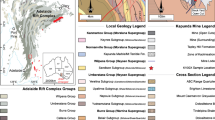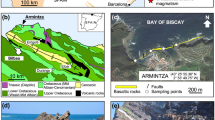Abstract
A new and rare suite of radioactive, plutonic-hypabyssal, non-peralkaline to peralkaline, potassic to perpotassic syenites have been reported as dyke-like and/or lensoid bodies (c. 100 m × 20 m to 5 m × 2 m) within the Buxa and Daling formations (Proterozoic) and Gondwana Group of rocks (Permo-Carboniferous) within the Ranjit tectonic window (RTW) and its peripheral parts in south Sikkim. These are christened in this work as ‘Sikkimites’ considering their unique field occurrences, petrography, mineralogy and geochemistry, unlike any known saturated potassic - perpotassic syenites from the plutonic environment from India or elsewhere. The modal (vol.%) mineralogical variations observed within the potassic syenites include orthoclase (57–65%) with subordinate to minor amounts of brown alkali amphibole (kataphorite, 3–32%), aegirine (1–20%), biotite (13% in one sample), opaque minerals (ilmenite and magnetite, 4.2–24.5%), quartz (traces to 12.9%) and minor to trace amounts (< 3%) of apatite, sphene, zircon, and monazite. Compositionally, the Sikkimite suite range from non-peralkaline to highly peralkaline types (with Mol. Na2O + K2O/Al2O3 varying from<1 to 1.2 to 1.5), mildly-perpotassic (Mol. K2O/Al2O3>0.83 to 0.96) and perpotassic (Mol. K2O/Al2O3>1 and Wt.% K2O/Al2O3 = 2.52–23.9) and Wt.% K2O/Na2O(3.05–23.9). The potassic syenites shows wide variations in major, minor and trace elements with significant enrichments in TiO2, Ba, REE, Y, Zr and Nb. The petrogenetic model for these rare potassic syenite suite of rocks (termed here as Sikkimite) invokes a near-primary origin by partial melting of enriched, amphibole- and phlogopite-bearing heterogeneous mantle, having chemical signatures of both non-subduction and subduction-related metasomatism. Ar40−Ar39 dates on them indicate a Cretaceous age (100−90 Ma) suggesting their links to either the widespread igneous manifestation of the Kerguelen or the Marion plume of the Indian Ocean.. These rare potassic syenites were apparently brought to the near surface environments in south Sikkim due to the collision of Greater India with Asia and the ensuing Himalayan thrusts from the north (MCT1 and MCT2) which shifted the crystalline basement and the Gondwana rocks maximum to the south, unlike any other parts of the Himalaya.
Similar content being viewed by others
References
Appleton, J.D. (1972) Petrogenesis of potassium-rich lavas from Roccamonfina Volcano, Roman Region, Italy. Jour. Petrol., v. 13, pp.425–456.
Avanzinelli, R., Lustrino, M., Mattei, M., Melluso, L., and Conticelli, S. (2009) Potassic and ultrapotassic magmatism in the circum-Tyrrhenian region: significance of carbonated pelitic vs. pelitic sediment recycling at destructive plate margins. Lithos, v.113, pp.213–227.
Bergman, S.C. (1987) Lamproites and other potassium-rich igneous rocks: a review of their occurrence, mineralogy and geochemistry. In: Fitton, J.G. and Upton, B.G.J. (Eds.), Alkaline Rocks, Geol. Soc. London Spec. Publ., no.30, pp.103–190.
Currie, K.L. (1989) New ideas on an old problem; the Peralkaline rocks. In: C. Leelanandam (Ed.), Alkaline Rocks. Mem. Geol. Soc. India., No.15, pp. 117–136.
Chalapathi Rao, N.V., Dongre, A., Fu-Yuan Wu, Lehmann, B. (2016) A Late Cretaceous (ca. 90 Ma) kimberlite event in southern India: Implication for sub-continental lithospheric mantle evolution and diamond exploration, Gondwana Res., v.35, pp.378–389.
Dubey, C.S., Villa, I.M., and Singh, N.P. (2009) Geochemistry and Geochronology of K-rich Syenites from Sikkim Eastern Himalaya. In: Santosh Kumar (Ed.), Magmatism, Tectonism and Mineralisation. Macmillan Publishers India Ltd., New Delhi, India.
Elliot, H.A.L., Wall, F., Chakhmouradian, A.R., Siegfriedm P.R., Dahlgren, S., Finch, A.A., Marks, M.A.W., Dowman, E., and Deady, E. (2018) Fenites associated with carbonatite complexes: A review. Ore Geol. Rev., v.93, pp.38–59.
Fitton, J.G. and Upton, B.G.J. (1987) Alkaline Igneous Rocks. Geol. Soc. London Spec. Publ., No.30, 568p.
Foley, S.F., Venturelli, G., Green, D.H., and Toscani, L. (1987) The ultrapotassic rocks: characteristics, classification and constraints for petrogenetic models. Earth Sci. Rev., v.24, pp.81–134.
Förster, M.F., Buhre, S., Xu, Bo, DejanPrelevi, D., Mertz-Kraus, R., and Foley, S.F. (2020) Two-stage origin of K-enrichment in ultrapotassic magmatism simulated by melting of experimentally metasomatized mantle. Minerals, v.10, 41; doi:https://doi.org/10.3390/min10010041
Furnes, H., Mitchell, J.G., Robins. B., Ryan, P., Skerlie, F.J. (1982) Petrography and geochemistry of peralkaline, ultrapotassic syenite dykes of Middle Permian age, Sunnfjord, West Norway. Norsk Geologisk Tidsskrift, v.62, pp.147–159.
Ghatak, A. and Basu, A.R. (2013) Isotopic and trace element geochemistry of alkali-mafic-ultramafic-carbonatitic complexes and flood basalts in NE India: Origin in a heterogeneous Kerguelen plume. Geochim. Cosmochim. Acta, v.115, pp.46–72.
Gupta, R.K., Perumal, N.V.A.S., Sagar, S., Upadhyayay, L.D., and Varma, H.M. (1989) Uranium mineralization in some typical igneous-metamorphic environments of India. In: Uranium Deposits in Magmatic and Metamorphic rocks. Proc. Tech. Comm. Meet., IAEA-Tc-571/8, held at Salamanca, pp.113–129.
Hughes, C.J. (1982). Igneous Petrology, Elsevier, Amsterdam, 551 p. Second edition, McGraw Hill Book Company, New York, 786 p.
Hyndman, D.W. (1985) Petrology of Igneous and Metamorphic Rocks (Second Edition). McGraw-Hill Book Co., New York, p.786.
Jagmer Singh, Saxena, D.N., Varma, H.M., and Dhana Raju (1983) Rare radioactive perpotassic alkali syenites from parts of South Sikkim, India. Curr. Sci., v.21, pp.162–164.
Krishnamurthy, P., and Cox, K.G. (1980) A potassium-rich alkalic suite from the Deccan Traps, Rajpipla, India. Contrib. Mineral. Petrol., v.73, pp.179–189.
Krishnamurthy, P. (2020a) The Deccan Volcanic Province (DVP), India: a review: Part 1: Areal extent and distribution, compositional diversity, flow types and sequences, stratigraphic correlations, dyke swarms and sills, petrography and mineralogy. Jour. Geol. Soc. India, v.96, pp.5–35.
Krishnamurthy, P. (2020b) The Deccan Volcanic Province (DVP), India: a review: Part 2: Geochemistry, petrological evolution, petrogenesis, mantle sources, age and erupted volume relations, Upper Cretaceous-Palaeogene (K-Pg) mass extinctions, economic aspects, summary and future studies in DVP. Jour. Geol. Soc. India, v.96, pp.111–147.
Krmíèek, L., and Chalapathi Rao, N.V. (2021) Lamprophyres, Lamproites and related rocks: Tracers to Supercontinent Cycles and Metallogenesis. Geol. Soc. London Spec. Publ. No.513. doi:https://doi.org/10.1144/SP513-2021-159
Leelanandam, C. (1989) Alkaline Rocks. (Ed.). Mem. Geol. Soc. India, No.15, 311 p.
Le Maitre, R.W. (Ed.), (2002) Igneous Rocks: a Classification and Glossary of Terms. Cambridge University Press, p.236.
McBirney, A.R. (1984) Igneous Petrology. Freeman, Cooper and Co., USA, p.394.
Mitra, G., Bhattacharya, K. and Mukul, M. (2010) The Lesser Himalayan Duplex in Sikkim: Implications for variations in Himalayan shortening. Jour. Geol. Soc. India., v.75, pp.289–311.
Nair, N.G.K., Santosh, M., and Thampi, P.K. (1984) Alkali granite-syenite-carbonatite association in Munnar, Kerala, India: implications for rifting, alkaline magmatism and liquid immiscibility. Proc. Indian Acad. Sci. (Earth Planet. Sci.), v.93, pp.149–158.
O’Hara, M.J. and Yoder, H.S. (1967) Formation and fractionation of basic magmas at high pressures. Scott. Jour. Geol., v. 3, pp. 67–117.
Pande, K., Sheth, H.C., Bhutani, R. (2001) 40Ar-39Ar age of the St. Mary’s Islands volcanics, southern India: record of India-Madagascar break-up on the Indian continent. Earth Planet. Sci. Lett., v.193, pp.39–46.
Parthasarathy, T.N., Parihar, P.S., and Krishna, K.V.G. (1990) Potash feldspar-rich alkaline rocks of Rangit Tectonic Window, South Sikkim: their genesis and relation to uranium, thorium, and REE mineralization in the area. Explor. Res. Atom. Minerals, v.3, pp.115–130.
Peccerillo, A. (1992) Potassic and ultrapotassic rocks: Compositional characteristics, petrogenesis, and geologic significance. Episodes, v.15, pp.243–251.
Radhakrishna, T., Maluski, H., Mitchell, J.G., Joseph, M., (1999) K-Ar and 40Ar/39Ar isotope geochronology of the dykes from the south Indian granulite terrain. Tectonophysics, v.304, pp.109–129.
Ratnakar, J. and Leelanandam, C. (1989) Petrology of alkali plutons from the eastern and southern Peninsular India. In: C. Leelanandam (Ed.), Alkaline Rocks. Mem. Geol. Soc. India, No.15, pp.145–176.
Rogers, N.W., Hawkesworth, C.J., Parker, R.J., and Marsh, J.S. (1985). The geochemistry of potassic lavas from Vulsini, Central Italy and implications for mantle enrichment processes beneath the Roman region. Contrib. Mineral. Petrol., v.90, pp.244–257.
Sahama, T.G. (1974) Potassium-rich alkaline rocks. In: H. Sorensen (Ed.), The Alkaline Rocks. John Wiley, London, pp.94–109.
Santosh, M. and Thara, K.G. (1985) The Mannapra syenite, Central Kerala, India: Geochemistry, petrogenesis and bearing on an orogenic magmatism. Proc. Ind. Acad. Sci. (Earth Planet. Sci.), v.94, pp.43–56.
Srivastava, R.K., Melluso, L., and Sinha, A.K. (2016) Petrogenesis of an early Cretaceous potassic lamprophyre dyke from Rongjeng, East Garo Hills, Shillong plateau, north-eastern India. Curr. Sci., v.110, pp.649–658.
Siddique, A.S., and Dhana Raju, R.D. (1986) Uranium mineralization in the carbonate rocks and sandstones from the Subuk-Rishi area of Sikkim Himalayas. Jour. Geol. Soc. India, v.27, pp.379–383.
Sinha Roy, S. (1976) Tectonic elements in the Eastern Himalaya and geodynamic model of evolution of the Himalaya. Geol. Surv. India, Misc. Publ., no.34 Part 1, pp. 57–74.
Sinha Roy, S. and Furnes, H. (1978) Geochemistry and geotectonic implications of basic volcanic rocks in the lower Gondwana sequence (Upper Paleozoic) of the Sikkim Himalayas. Geol. Mag., v.115, pp.427–436.
Sorenson, H. (1974) The Alkaline Rocks. John Wiley, London.
Streckeisen, A.L. (1976). Classification and Nomenclature of Igneous Rocks. Neus. Jahrb. Miner. Abh., v.107, pp.144–240.
Sunil Kumar, Dhana Raju, R., Varma, H.M., and Dougall, N.K. (1984) Cancrinite-tinguaite and K-rich trachyte in the Nongcharam-Darugiri area of East Garo Hills District, Meghalaya: A Preliminary study. Jour. Geol. Soc. India, v. 25(8), pp. 528–532.
Upton, B.G.J. and Thomas, J.F. (1973) Precambrian potassic ultramafic rocks: South Greenland. Jour. Petrol., v.14, pp.509–534.
Varma, H.M., Dhana Raju, R., Singh, J., and Saxena, D.N. (1988) Geochemistry of ultrapotassic syenites from Sikkim Himalayas. Explor. Res. Atom. Minerals, v.1, pp.57–80.
Wang, Yu, Foley, S.F. and DejanPreleviæ, D. (2017). Potassium-rich magmatism from a phlogopite-free source. Geology, v.45(5), pp.467–470.
Acknowledgements
HMV acknowledges the keen interest and inspiration by Shri T. M. Mahadevan, former Director of AMD during the various stages of the work. PK would like to acknowledge the help received from Director, AMD, Dr. D.K. Sinha, in providing data from AMD’s 1972 Annual Reports pertaining to the discovery of these rare syenites from Sikkim initially by Shri A.P. Roy and R.K. Gupta. Shri P.S. Parihar, formerly Director, AMD who had worked in Sikkim provided important inputs on field relations of the Sikkimite. Shri. Choudhary, Regional Director, AMD, Southern Region, Bengaluru and Ms. Sangeetha Bagat, AMD, Hyderabad for providing the library-reference support. Dr. Purva Gadapallu, Department of Geology, Savitribai Phule Pune University, helped in preparing the diagrams with great patience in spite of the repeated changes in contents and format. The authors are also thankful to the reviewer for the suggestions to further improve the manuscript.
Author information
Authors and Affiliations
Corresponding author
Additional information
‘Saturated potassic to perpotassic rocks of clear alkaline affinity are not found in a plutonic environment.........and the generation of the potassic to perpotassic magmas is most probably complex and can hardly be attributed to the operation of just one single process of a more universal application’ — Th. G. Sahama, 1974
Rights and permissions
About this article
Cite this article
Varma, H.M., Singh, J., Krishnamurthy, P. et al. Sikkimite: A New and Rare Suite of Potassic-perpotassic Syenites from South Sikkim, Lesser Himalaya, India. J Geol Soc India 98, 314–322 (2022). https://doi.org/10.1007/s12594-022-1982-5
Received:
Accepted:
Published:
Issue Date:
DOI: https://doi.org/10.1007/s12594-022-1982-5




